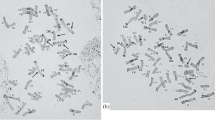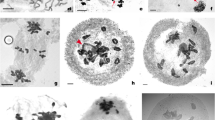Abstract
The paper presents the results of zygotic autopolyploidization by the nitrous oxide (N2O) of diploid cultivars and F1 hybrids of winter rye. It has been shown that the method of creating zygotic rye tetraploids by the nitrous oxide (N2O) is effective and allows obtaining up to 86.0% of tetraploids. The average yield of tetraploids was 51.0%. Nine new rye tetraploids were created with this method. The created tetraploids are characterized by chromosomal balance and low levels of aneuploidy (up to 9.7%). Meiosis in rye zygotic tetraploids occurs with significantly more defections (P ≤ 0.05) than in the original diploids. It has been established that part of the nuclear DNA is eliminated in the created tetraploids to the C6–C7 generations. On the basis of the obtained tetraploid Yubileinaya, a new variety of winter tetraploid rye Camea 16 was created.



Similar content being viewed by others
REFERENCES
Schlegel, R., Hybrid breeding boosted molecular genetics in rye, Vavilov J. Genet. Breed., 2015, vol. 19, no. 5, pp. 589–603. https://doi.org/10.18699/VJ15.076
Privalov, F.I. and Urban, E.P., Achievements and problems of high yield crops breeding in the republic of Belarus, Proc. Natl. Acad. Sci. Belarus, Ser. Agr. Sci., 2016, no. 3, pp. 41–49.
Pfahler, P.L., Barnett, R.D., and Luke, H.H., Diploid-tetraploid comparisons in rye. IV. Grain production, Crop Sci., 1987, vol. 27, no. 3, pp. 431–435. https://doi.org/10.2135/cropsci1987.0011183X002700030001x
Gordej, I.S., Structural changes of rye genome after zygotic duplication, Mol. Appl. Genet., 2016, vol. 21, pp. 37–45.
Lundqvist, A., Heterosis and inbreeding depression in autotetraploid rye, Heredity, 1966, vol. 56, nos. 2/3, pp. 317–366. https://doi.org/10.1111/j.1601-5223.1966.tb02084.x
Dorsey, E., Induced polyploidy in wheat and rye: chromosome doubling in Triticum, Secale and Triticum–Secale hybrids produced by temperature changes, J. Hered., 1936, vol. 27, no. 4, pp. 155–160. https://doi.org/10.1093/oxfordjournals.jhered.a104195
Marasek-Ciolakowska, A., Nishikawa, T., Shea, D., and Okazaki, K., Breeding of lilies and tulips, Interspecific hybridization and genetic background, Breed Sci., 2018, vol. 68, no. 1, pp. 35–52. https://doi.org/10.1270/jsbbs.17097
Berdahl, J. and Barker, R., Characterization of autotetraploid Russian wild rye produced with nitrous oxide, Crop Sci., 1991, vol. 31, no. 5, pp. 1153–1155. https://doi.org/10.2135/cropsci1991.0011183X003100050014x
Chen, Z. and Ni, Z., Mechanisms of genomic rearrangements and gene expression changes in plant polyploids, BioEssays, 2006, vol. 28, no. 3, pp. 204–252. https://doi.org/10.1002/bies.20374
Liu, B., Xu, C., Zhao, N., Qi, B., Kimatu, J., Pang, J., and Han, F., Rapid genomic changes in polyploid wheat and related species: implications for genome evolution and genetic improvement, J. Genet. Genomics, 2009, vol. 36, no. 9, pp. 519–528. https://doi.org/10.1016/S1673-8527(08)60143-5
Lavergne, S., Muenke, N., and Molofsky, J., Genome size reduction can trigger rapid phenotypic evolution in invasive plants, Ann. Bot., 2010, vol. 105, pp. 109–116. https://doi.org/10.1093/aob/mcp271
Adams, K., Polyploidy and genome evolution in plants, Curr. Opin. Plant Biol., 2005, vol. 8, no. 2, pp. 135–141. https://doi.org/10.1016/j.pbi.2005.01.001
Belko, N.B., Gordej, I.A., Shchetko, I.S., and Gordej, I.S., Creating tetraploid forms of winter rye using nitrous oxide and the genetic effects of genome duplication, Fact. Exp. Evol. Organisms, 2011, vol. 10, pp. 14–19.
Gaaliche, B., Majdoub, A., Trad, M., and Mars, M., Assessment of pollen viability, germination, and tube growth in eight Tunisian caprifig (Ficus carica L.) cultivars, Int. Schol. Res. Not., ISRN Agronomy, 2013. https://doi.org/10.1155/2013/207434
Jellen, E., C-banding of plant chromosomes, Methods Mol. Biol., 2016, vol. 1429, pp. 1–5. https://doi.org/10.1007/978-1-4939-3622-9_1
Pichugin, Yu.G., Semyanov, K.A., Chernyshev, A.V., Palchikova, I.G., Omelyanchuk, L.V., and Maltsev, V.P., Nucleus DNA content measurement methods features, Cytology, 2012, vol. 54, no. 2, pp. 185–190.
Bai, C., Alverson, W., Follansbee, A., and Waller, D., New reports of nuclear DNA content for 407 vascular plant taxa from the United States, Ann. Bot., 2012, vol. 110, no. 8, pp. 1623–1629. https://doi.org/10.1093/aob/mcs222
McCleery, R., Watt, T., and Hart, T., Introduction to Statistics for Biology, Chapman and Hall/CRC, 2007, 3rd ed. https://doi.org/10.1093/aob/mcp223
Kitamura, S., Mechanism of action of nitrous oxide gas applied as a polyploidizing agent during meiosis in lilies, Sex. Plant Reprod., 2009, vol. 22, no. 1, pp. 9–14. https://doi.org/10.1007/s00497-008-0084-x
Leitch, I. and Bennet, M., Genome downsizing in polyploidy plants, Biol. J. Linn. Soc., 2004, vol. 82, no. 4, pp. 651–663. https://doi.org/10.1111/j.1095-8312.2004
Bennett, M., Bhandol, P., and Leitch, I., Nuclear DNA amounts in angiosperms and their modern uses—807 new estimates, Ann. Bot., 2000, vol. 86, no. 4, pp. 859–909. https://doi.org/10.1006/anbo.2000.1253
Raina, S., Parida, A., Koul, K., Salimath, S., Bisht, M., Raja, V., and Khoshoo, T., Associated chromosomal DNA changes in polyploids, Genome, 1994, vol. 37, no. 4, pp. 560–564.
Martelotto, L., Ortiz, J., Juliana, S., and Francisco, E., Genome rearrangements derived from autopolyploidization in Paspalum sp., Plant Sci., 2007, vol. 172, no. 5, pp. 970–977. https://doi.org/10.1016/j.plantsci.2007.02.001
Ozkan, H., Levy, M., and Feldman, A., Allopolyploidy-induced rapid genome evolution in the wheat (Aegilops–Triticum), Plant Cell, 2001, vol. 13, no. 8, pp. 1735–1747.
Gustafson, J. and Bennett, M., The effect of telomeric heterochromatin from Secale cereale on Triticale (Triticosecale). I. The influence of the loss of several blocks of telomeric heterochromatin on early endosperm development and kernel characteristics at maturity, Genome, 2011, vol. 24, no. 1, pp. 83–92. https://doi.org/10.1139/g82-008
Devos, K., Brown, J., and Bennetzen, J., Genome size reduction through illegitimate recombination counteracts genome expansion in Arabidopsis, Genome Res., vol. 12, no. 7, pp. 1075–1079. https://doi.org/10.1101/gr.132102
Kravets, E.A., Sidorchuk, Yu.V., Horyunova, I.I., Plohovskaya, S.H., Mursalimov, S.R., Deineko, E.V., Yemets, A.I., and Blume, Ya.B., Intra- and intertissular cytomictic interactions in the microsporogenesis of mono- and dicotyledonous plants, Cytol. Genet., 2016, vol. 50, no. 5, pp. 3–16.
Butrille, D. and Boiteux, L., Selection-mutation balance in polysomic tetraploids: Impact of double reduction and gametophytic selection on the frequency and subchromosomal localization of deleterious mutation, Proc. Natl. Acad. Sci. U. S. A., 2000, vol. 97, no. 12, pp. 6608–66013. https://doi.org/10.1073/pnas.100101097
Kunakh, V.A., Ontogenetic plasticity of the genome as the basis for plant adaptability, in Zhebrakov’s Readings III Transformation of Genomes, Minsk: Pravo i economica, 2011.
Funding
This study was not supported by any grant provided by any governmental, commercial, or noncommercial establishment.
Author information
Authors and Affiliations
Corresponding author
Ethics declarations
The authors declare that they have no conflict of interest. This article does not contain any studies involving animals or human participants performed by any of the authors.
Additional information
Translated by M. Bibov
About this article
Cite this article
Gordej, I.S., Lyusikov, O.M. & Gordej, I.A. Zygotic Autopolyploidization of Rye (Secale cereale L.). Cytol. Genet. 53, 357–362 (2019). https://doi.org/10.3103/S0095452719050086
Received:
Revised:
Accepted:
Published:
Issue Date:
DOI: https://doi.org/10.3103/S0095452719050086




